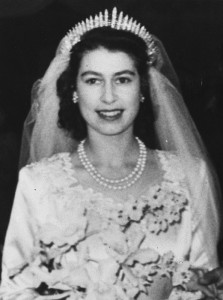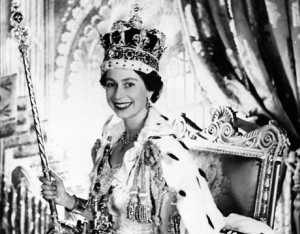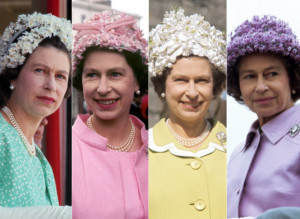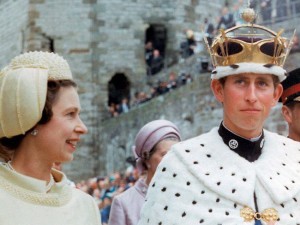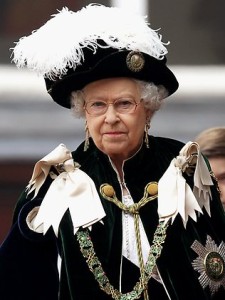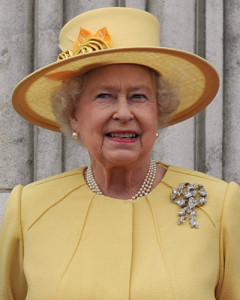Queen Elizabeth II has generally not been known in the past years for her fashion style. But that changed when in 1994 when Angela Kelly was named the Queen’s personal dresser, you could say she is the royal stylist. Since that time the Queen’s wardrobe seems to have undergone a fashion transformation with more tailored dresses and coats made in solid pastels or bold primary colors or sometimes the dresses are made in fabric with simple patterns. But the outfits are always accessorized with sensible shoes and the ever present handbag (I am still wondering what is in that handbag!). To complete the fashion ensemble, the Queen will wear pieces from her personal jewelry collection. During the day, the Queen will usually wear a hat specifically made to match the dress that she is wearing. On more formal occasions the Queen will wear one of the spectacular crowns from the Royal Jewelry Collection.
In this post I will discuss the many hats of Queen Elizabeth, but let’s start when she was a young Princess. Shown below in the photo on the left is the infant Elizabeth sitting in her pram wearing a lacy bonnet. Then, at the age of 11 years old her father unexpectedly became King George VI and the young Princess Elizabeth and her sister Margaret wore specially made golden coronets to the coronation as shown below in the photo on the right.
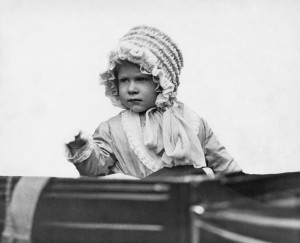
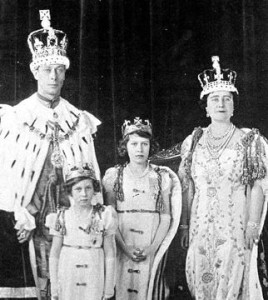
As the years passed, Princess Elizabeth grew into a lovely young women. Shown in the photo on the left she is wearing the uniform and hat of the Girl Guide in 1942. Then, during World War II, Princess Elizabeth joined the Women’s Auxiliary Territorial Service as a truck mechanic and she is shown in the photo on the right wearing the uniform and hat of the ATS.
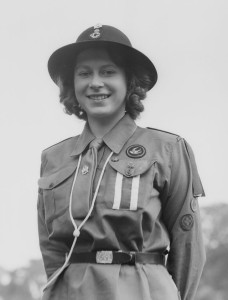
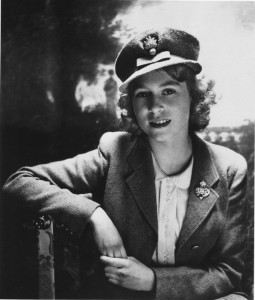
On the occasion of Princess Elizabeth wedding to Prince Phillip on November 20, 1947 she wore a beautiful embroidered ivory silk duchess wedding gown designed by Norman Hartnell. To complete her wedding ensemble, Princess Elizabeth wore a silk tulle veil held in place with the diamond King George III Fringe Tiara. Unfortunately, on the wedding day the frame of the tiara broke in half but luckily the royal jeweler was quickly called in to make the repair before the ceremony. Shown below is a photo of Princess Elizabeth on her wedding day. (For more information about her wedding to Prince Phillip, please click on the link to British Royal Weddings – Part Three. Also, for more detailed information about Prince Elizabeth’s wedding dress and her other bridal accessories that she wore on her wedding day, please click on the link to British Royal Wedding Dresses – Part Two)
Shown below in the photos is Princess Elizabeth at the christening of her first two children. On the left is a photo on the occasion of Prince Charles’ christening in 1948 and she is wearing a red-orange dress with a matching hat with a large bow and netting. On the right is a photo of her at the christening of Princess Anne in 1950 and she is wearing a light blue print dress and a matching blue velvet hat decorated a rather unusual fringe accent (sort-of like a blue whisk broom!)
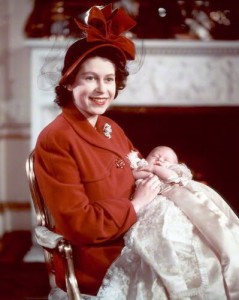
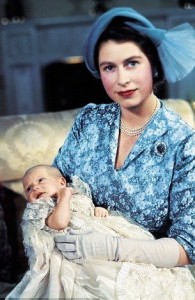
In 1952, upon the death of her beloved father, Princess Elizabeth became Queen Elizabeth II. For her June 2, 1953 coronation Queen Elizabeth wore another beautiful and intricately embroidered white silk gown specially designed for the occasion by Norman Hartnell. During the most solemn part of the coronation ceremony, Queen Elizabeth was crowned with the St. Edward’s Crown. (For more detailed information regarding the Coronation of Queen Elizabeth, please click on the link)
During the 1960s and 1970s, the Queen often wore hats with floral accents designed by the Pennsylvania-based milliner Sally Victor who owned one the largest millinery companies in America. Shown below are some examples of those hats.
For the Investiture of her son, Prince Charles, as the Prince of Wales on July 1, 1969 at Caernarfon Castle the Queen wore a hat which caused some controversy when she chose to wear it instead of a crown, the Welsh people felt that the important ceremony warranted it. Although the hat created by milliner Simone Mirman did match her pale yellow dress, it was a Tudor-inspired hat with two rather large pieces covering her ears. Mirman had often worked closely throughout the years with the designer Hartnell who was a favorite dress maker of the Queen.
An annual event held at St. George’s Chape at Windsor Castle is the Order of the Garter Ceremony. For this event which is held every year in mid-June the Queen and other members of the Order wear special robes and accessories. One of those items is the Garter Hat styled as a Tudor Bonnet, a traditional soft crowned round brimmed cap made in black velvet and trimmed with a white ostrich plume and black heron feathers. Attached to the hat is a badge of the heraldic shield of St. George which is encircled by the Garter of the Order. (For more detailed information at the Order of the Carter Ceremony, please click on the link)
Another annual event which is also held in June is the five-day horse race known as Royal Ascot. The Queen and other female members of the royal family, along with the public , that attend the event, take the opportunity to select specially decorated hats. Shown below are some photos of the hats that the Queen has worn in past years.

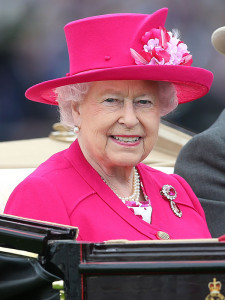
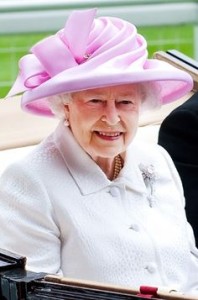
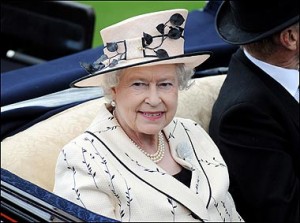
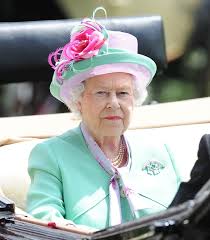
Queen Elizabeth has had several milliners throughout the years that have made thousands of hats. Along with the two milliners previously mentioned, the Queen has had hats created in the past by the British milliner Frederick Fox, Marie O’Reagan of the London College of Fashion and the Danish milliner Aage Thaarup. Since the 1980s through to his retirement in 2008, the New Zealand born but London-based Philip Somerville had the distinction of being the Royal Milliner. Somerville was known for his use of unusual fabrics and trimming made in vibrant colors. Most recently the Irish milliner Philip Treacy designed the hat that the Queen wore to the wedding of her grandson Prince William to Kate Middleton, this hat is shown in the photo below.
When a milliner is creating a hat for the Queen there are a couple of important things to consider, such as the style and the fit. The Queen’s hat needs to serve several purposes. The first is that it covers the Queen’s head eliminating the need for constant hair touch-ups during the day which is usually scheduled with several engagements and appearances at various functions. The second purpose of wearing a hat is that it covers the Queen’s head to protect her from any weather conditions, such as glaring sun or a sudden rain shower (although lately the Queen had begun to use a clear umbrella with a color coordinated stripe to match her clothing). Finally, the third purpose of wearing a hat is that is a fashion opportunity to add an extra decorative accessory to the Queen’s outfit.
When traveling to different countries, the style of the hat will take into consideration the culture and customs of the country that the Queen is visiting. An example shown in the photos below is when the Queen has visited the Pope at the Vatican she will wear a mantilla to cover her head. The photo on the left shows the Queen with Pope John Paul II wearing a crown with the mantilla and the photo on the shows the Queen several years later with Pope John Paul II wearing a hat with a mantilla attached.
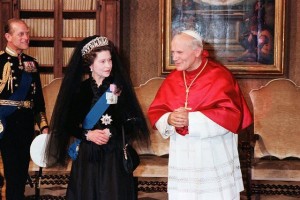
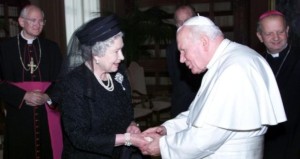
Finally, when the Queen is at a public engagement, she needs to be able to see the people and they need to see her. So, when creating a hat the milliner needs to make sure that the brim is not so large that it will cover the Queen’s face. Also, the upper portion of the hat needs to be a proper height so that the Queen can enter/exit her vehicle without hitting the hat and knocking it out of place on her head.

